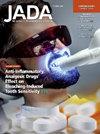Trigeminal neuralgia originating in the tongue
IF 3.1
2区 医学
Q1 DENTISTRY, ORAL SURGERY & MEDICINE
引用次数: 0
Abstract
Background
Trigeminal neuralgia originating primarily in the anterior two-thirds of the tongue is a rare type of neuropathic pain condition predominantly involving the lingual branch of the mandibular (V3) component after pathologic changes in the lingual nerve. Diagnosis involves meticulous evaluation of patient history, symptoms, and clinical signs; investigations ranging from combinations of topical anesthetics to different types of nerve blocks; and varying imaging modalities, such as conventional radiography and magnetic resonance imaging.
Case Description
The authors describe a case of neuralgia predominantly involving the lingual nerve. A detailed timeline, including misdiagnosis of the condition and complete management and follow-up, is also described, along with a discussion of the literature. The authors also highlight the importance of the basic diagnostic skill sets required for a dentist in such cases, without which a patient may receive unnecessary treatment.
Practical Implications
Clinical examination, anesthetic nerve blocks, and magnetic resonance imaging play roles in diagnosing and differentiating nonodontogenic orofacial pain, especially neuropathic and musculoskeletal pain and headache. However, for odontogenic and osteogenic pathologies, cone-beam computed tomography remains the reference standard. Pharmacotherapy has its own obstacles in long-term prognosis due to potential adverse effects, decreased quality of life, and limitations in alleviating the pain. A decompression surgery may be imperative, as in this case, in which pharmacotherapy failed to produce long-term beneficial results.
起源于舌头的三叉神经痛
背景:三叉神经痛主要发源于舌前三分之二,是一种罕见的神经性疼痛,主要累及舌神经病变后下颌舌支(V3)部分。诊断包括对患者病史、症状和临床体征的细致评估;调查范围从局部麻醉药的组合到不同类型的神经阻滞;以及不同的成像方式,如常规放射成像和磁共振成像。病例描述作者描述了一例神经痛主要涉及舌神经。详细的时间表,包括误诊和完整的管理和随访,也被描述,随着文献的讨论。作者还强调了在这种情况下牙医所需要的基本诊断技能的重要性,没有这些技能,病人可能会接受不必要的治疗。临床检查、麻醉神经阻滞和磁共振成像在诊断和鉴别非牙源性口面部疼痛,特别是神经性、肌肉骨骼性疼痛和头痛方面发挥着重要作用。然而,对于牙源性和成骨性病变,锥束计算机断层扫描仍然是参考标准。由于潜在的不良反应、生活质量下降和减轻疼痛的局限性,药物治疗在长期预后方面存在障碍。减压手术可能是必要的,在这种情况下,药物治疗未能产生长期有益的结果。
本文章由计算机程序翻译,如有差异,请以英文原文为准。
求助全文
约1分钟内获得全文
求助全文
来源期刊

Journal of the American Dental Association
医学-牙科与口腔外科
CiteScore
5.30
自引率
10.30%
发文量
221
审稿时长
34 days
期刊介绍:
There is not a single source or solution to help dentists in their quest for lifelong learning, improving dental practice, and dental well-being. JADA+, along with The Journal of the American Dental Association, is striving to do just that, bringing together practical content covering dentistry topics and procedures to help dentists—both general dentists and specialists—provide better patient care and improve oral health and well-being. This is a work in progress; as we add more content, covering more topics of interest, it will continue to expand, becoming an ever-more essential source of oral health knowledge.
 求助内容:
求助内容: 应助结果提醒方式:
应助结果提醒方式:


